You have no items in your shopping cart.
0
You have no items in your shopping cart.
Today i'd like to talk about the interaction between mainlines and backup lines on highlines of all lengths. There have been a few incidents recently that have shown us that there may be some significance in how these two lines interact with each other at different tensions, lengths, tape spacings, material shapes, and materials. I'd like to show two examples of these at play and present a few issues that they both show. I'd also like to propose some changes to the way we rig highlines moving forward.
In June of 2016, there was an incident at the French Riviera Highline Meeting where an 800m highline rigged with Balance Community Feather PRO and 6mm Dyneema Rope backup experienced some severe damage to the mainline. The damage was bad enough that the line had to be closed and derigged. The reasons for this damage were unclear and discussed at great length on SlackChat (discussion here: https://www.facebook.com/groups/slackchat/permalink/1113352462071963/)
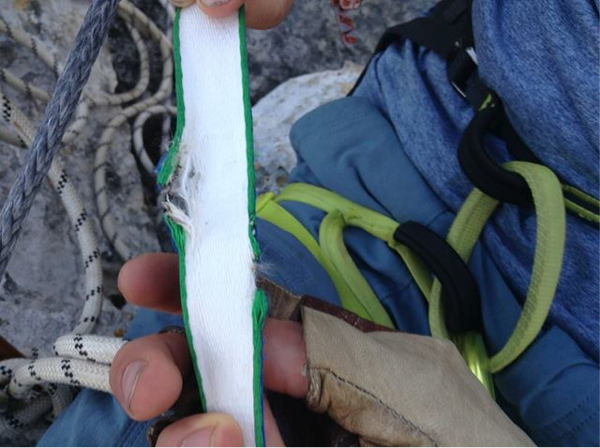
Some of the theories for the cause of the damage included lightning, excessive line-gliding, wind oscillations, and even damage from the high number of leash falls and catches the line saw during the event. The general consensus was that the damage resulted from some form of lightning or charge that passed through the line.
I was recently able to get my hands on the damaged section of Feather PRO and do some testing. Upon initial inspection, it looked like the damaged sections experienced some sort of abrasion rather than an electrical shock. Looking further, it was clear that some sort of extreme abrasion caused the damage. The directionality of the damage as well as the state of the cut ends indicated this was the case.
I did four break tests with this webbing using a pair of dedicated testing weblocks All tests were done near the damaged sections. The reason we tested the sections near the damage was that if the line was struck by lightning or was damaged by a charge (which was thought as the most likely reason for the damage), it should have affected not only the area that showed physical signs of damage, but also likely the entire area around the strike/damaged location. These four break tests all broke above 24 kN, staying in line with what Feather PRO breaks at in weblocks after major usage.


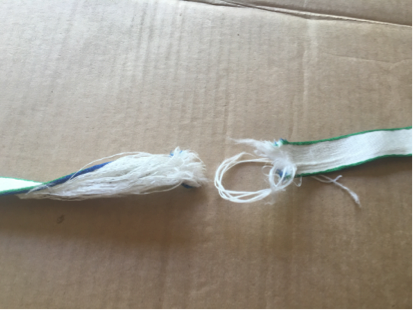
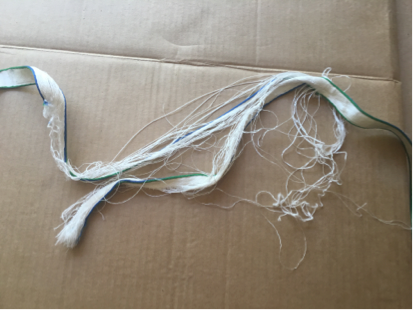
I also played around with how the backup line, which was ¼” (6mm) Dyneema Rope, would sit against the Feather PRO. I noticed while walking this big line that the backup had the tendency to wrap around the line quite a lot, especially after a number of falls. I aligned a piece of ¼” Dyneema Rope with several of the damaged areas and found that it aligned perfectly wth the directionality of the damage. It became clear that the cause of the majority of the damaged locations was from the backup line.

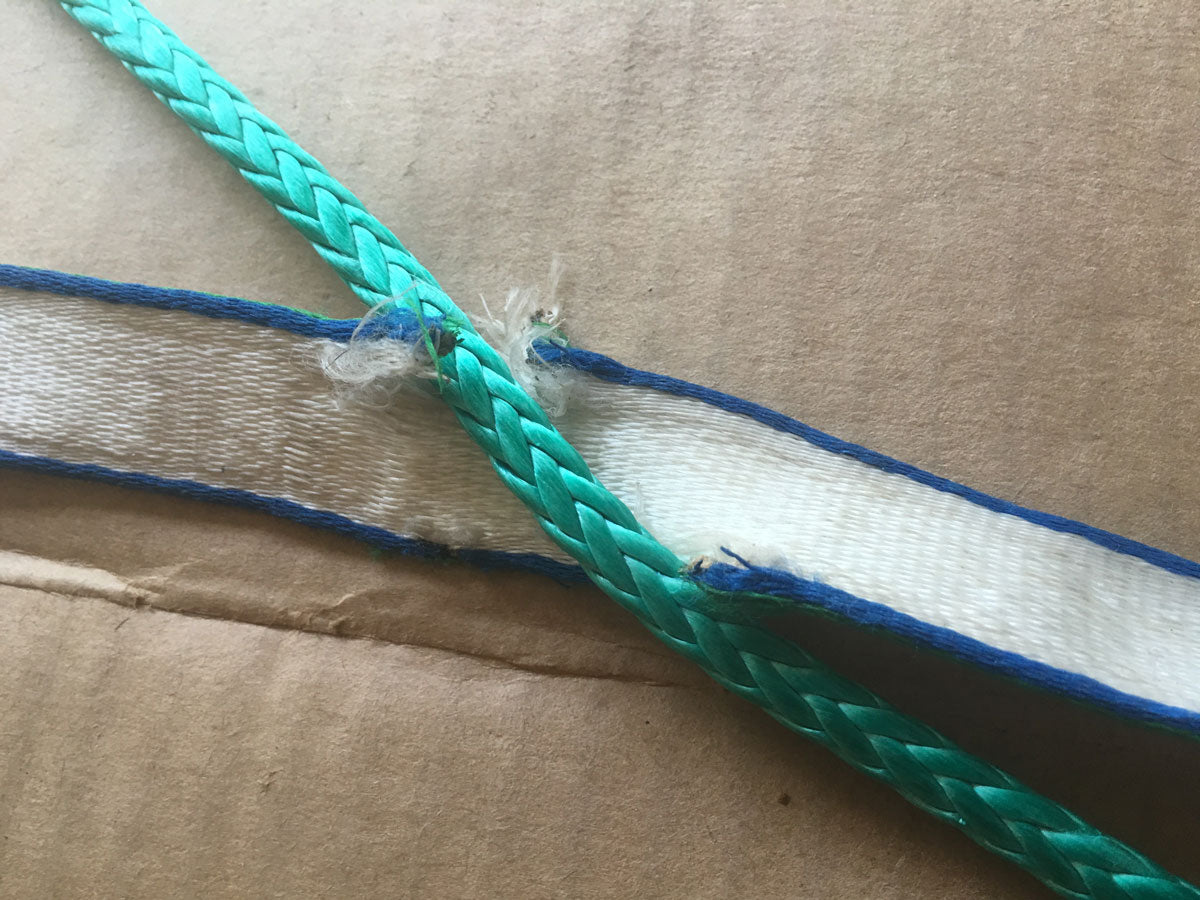
My new hypothesis is that while someone was on the line, the backup was wrapped around the mainline a large number of times. As they were on the line, they either pulled on the backup to fix these twists (which is quite common on big lines), took a fall and grabbed the backup line, or the leash rings somehow grabbed onto the backup line during a walk or fall. In any case, the backup was tensioned quickly somehow while it was wrapped around the webbing. This rapid tensioning of the backup sliding over the tensioned mainline caused melting and actually cut some of the edge fibers. I believe this is the cause of all the initial damage.
Furthermore, the reason that the damage was so extensive was very likely due to a less than ideal edge design on the original Feather PRO. The edge fibers were made from textured polyester, which has the tendency to abraid quicker than non-textured fibers. This has been changed on all current batches of Feather PRO. The edges are now made from a solution dyed polyester, which shows much better results on the abrasion test performed on all Balance Community slackline webbings.
The main reason the backup was wrapping around the mainline so much was because of the excessively large spacing between each tape (started with about 15m between each tape, which then grew to sections as long as 45m without any tapes). I see this backup wrapping happening quite frequently on big lines with huge spacing between the tapes. When a fall occurs on a highline, you will see a huge oscillation of the two lines, usually causing many backup twists. This damage that occurred on the 800m can easily happen on other lines with large tape spacing.

In addition to the tape spacing, another contributing factor to the damage was the shape of the backup line. Since it was a rope, the contact point with the mainline is focused to a single point. When a rope backup line is wrapped around the mainline and then slides, there are focused areas where the friction is very high, especially at or near tapes, where backup twists tend to congregate. This isn’t nearly as prevalent when using a webbing backup as the friction is spread across the width of both lines.
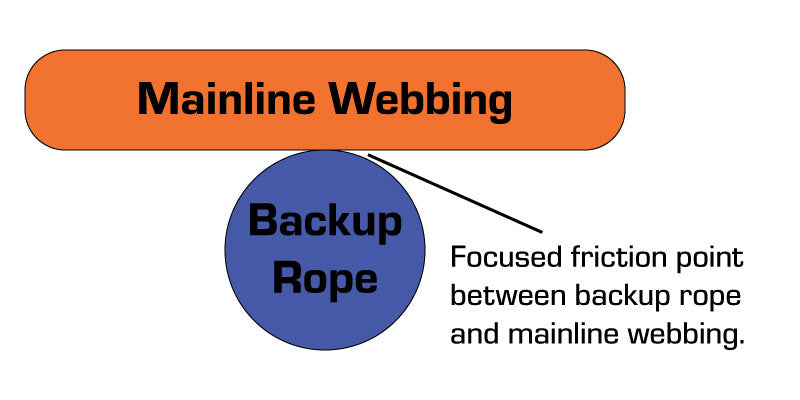
Several weeks after the FRHM festival, there was another long highline festival held in Switzerland, where there were three large highlines longer than 300m rigged with various materials. The shortest of the three was rigged with a nylon webbing mainline and a static rope backup. After derigging these lines and inspecting the entire length, there was damage found on the mainline underneath several tapes. It was found that the damaged locations were under tapes that were not “Slider Tapes”. Specifically, the only taped locations that showed no damage were those that were built using the slider tape method in this article: A Better Slider Tape Method.

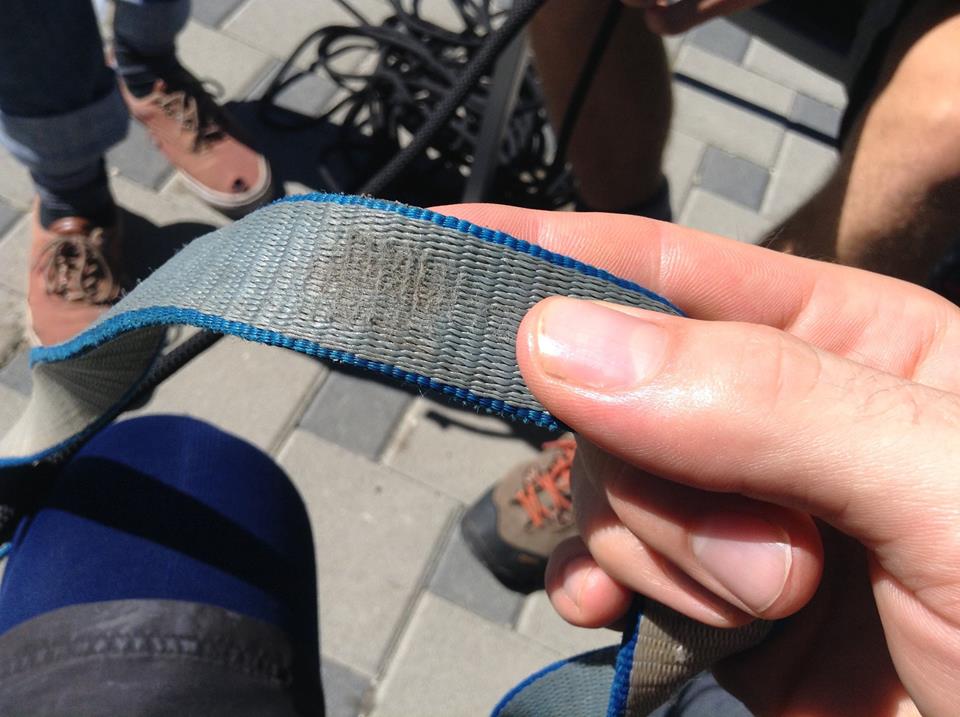
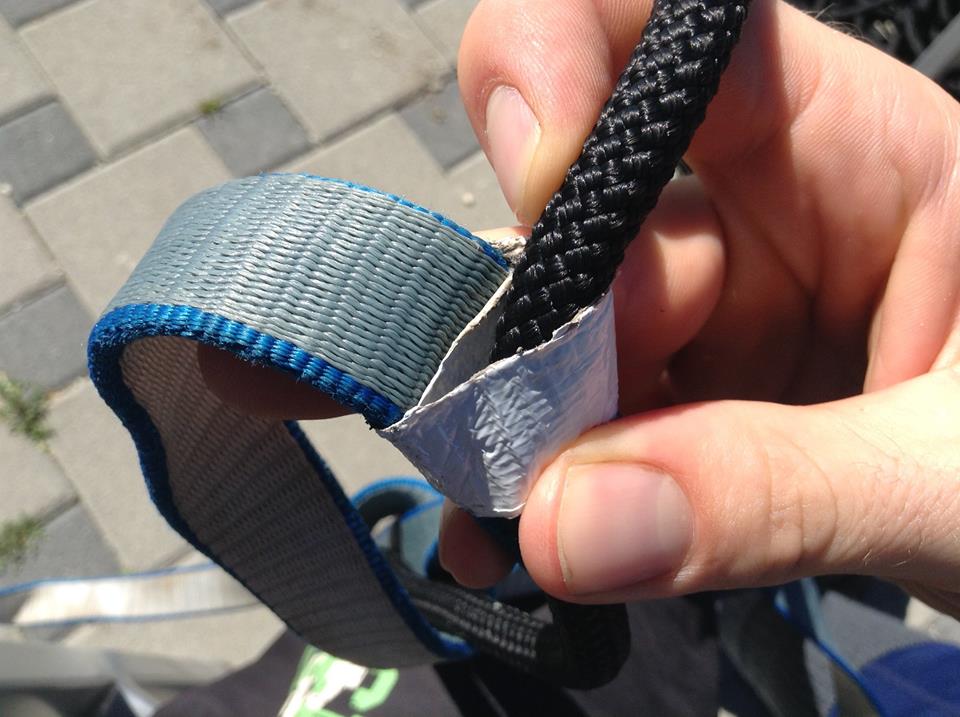
This taping method provides a barrier between the mainline and backup line where there is forced interaction between the two.
It has been shared with me that this setup was taped for a substantial amount of time (a month or longer) and saw several rigs with the tapes shown here. It is unclear which tapes were on the line for a long time and which were installed prior to the rig on this line. Regardless of this, the points about adding a barrier between backup and mainline at the tapes is still applicable.
There are four points I would like to get across after reviewing these two incidents:
Tape spacing has a big impact on mainline and backup line interactions, mainly due to the higher probability of backup twists happening (and remaining) when the tape spacing is large. This is especially true on lines that see a lot of usage and a high number of falls (catches, leash falls, etc.). Any time the line is moved suddenly and severely, a backup twist (or several) is likely (see picture above).
Backup twists can be a source of damage to a mainline, especially if there are a lot of adjustments being made to the backup throughout the session.
Rope backups, although preferable in many scenarios, have a much more focused area of friction when interacting with the mainline. This can be an issue when considering point 1 and 2 and dealing with a long highline where people will be pulling on and adjusting the backup throughout the session.
Slider Tapes that provide a barrier between backup line and mainline can be an excellent deterrent for abrasion between the two lines. Even without any backup twists, any highline that experiences dynamics on any axis (up & down, side-to-side, forward and backward) will experience sliding at the tapes. Having a barrier between mainline and backup line will help prevent damage to the mainline when these dynamics occur.
With these four points, I would propose the following adjustments to the styles of rigging moving forward:
Any time a line is rigged where large tape spacing is preferred (oscillation dampening, taping logistics on long highlines, etc.), consider using a webbing backup. There is more surface area to spread friction across, resulting in less probability of damage to either line with a mainline backup interaction.
When using a rope backup is preferred (abrasion risks, alpine missions, etc.), consider using a smaller tape spacing to prevent backup twists. The smaller the distance is between each tape, the more difficult it is for the backup line to wrap around the mainline. Combine this with point 3 to have an optimal rig with very low risk of mainline backup interaction damage.
Consider adding more tension to the backup line. With higher tensions, there is less likelihood that there will be any backup twists due to lack of slack between tapes. Using this method, it is possible to gain the advantages of large tape spacing without a huge risk of backup twists. The tighter the backup, the bigger your tape spacing can be without increasing backup twist potential.
Regardless of line length, consider switching your tape method to the slider tape method in this article:A Better Slider Tape Method. It uses a bit more tape, but it provides a barrier between your two lines and also helps prevent tapes from becoming completely disconnected from your line (thus causing litter).
That pretty much covers all that I wanted to discuss. Thank you for taking the time to read. Please feel free to comment below with any questions. You can also email questions to us at Info@balancecommunity.com.
| Product | Price | Quantity | Options | |||||
|---|---|---|---|---|---|---|---|---|
| Features |
| Availability: |
| Price |
| Options |
| Actions |

← Older Post Newer Post →
0 comments